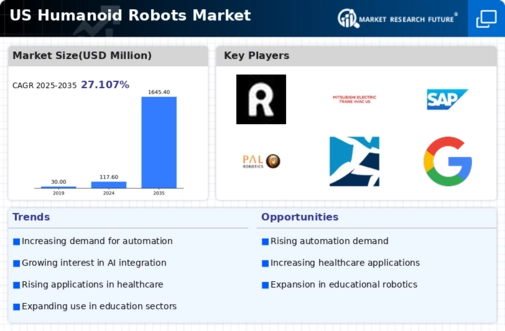The humanoid robots market is currently characterized by a dynamic competitive landscape, driven by advancements in artificial intelligence (AI), automation, and increasing demand for robotic solutions across various sectors. Key players such as Boston Dynamics (US), SoftBank Robotics (US), and Agility Robotics (US) are at the forefront, each adopting distinct strategies to enhance their market positioning. Boston Dynamics (US) focuses on innovation and has recently expanded its product line to include more versatile robots capable of performing complex tasks in diverse environments. Meanwhile, SoftBank Robotics (US) emphasizes partnerships and collaborations, leveraging its extensive network to integrate AI capabilities into its humanoid robots, thereby enhancing their functionality and appeal. Agility Robotics (US) is concentrating on regional expansion, particularly in North America, to capitalize on the growing demand for humanoid robots in logistics and healthcare sectors. Collectively, these strategies contribute to a competitive environment that is increasingly characterized by technological sophistication and collaborative efforts.
In terms of business tactics, companies are localizing manufacturing and optimizing supply chains to enhance efficiency and reduce costs. The market structure appears moderately fragmented, with several players vying for market share while also collaborating on technological advancements. This fragmentation allows for a diverse range of products and services, catering to various customer needs and preferences. The collective influence of these key players shapes the market dynamics, fostering an environment where innovation is paramount.
In November 2025, Boston Dynamics (US) unveiled its latest humanoid robot, designed specifically for warehouse operations, which is expected to streamline logistics processes significantly. This strategic move not only showcases the company's commitment to innovation but also positions it as a leader in the logistics sector, where efficiency is critical. The introduction of this robot could potentially enhance operational productivity by up to 30%, indicating a strong market response.
In October 2025, SoftBank Robotics (US) announced a strategic partnership with a leading AI firm to enhance the cognitive capabilities of its humanoid robots. This collaboration aims to integrate advanced machine learning algorithms, allowing robots to learn from their environments and improve their interactions with humans. Such advancements are likely to increase the robots' utility in customer service and healthcare, sectors that are increasingly reliant on automation.
In September 2025, Agility Robotics (US) secured a $50M investment to expand its research and development efforts, focusing on creating more adaptable humanoid robots. This funding is crucial for the company as it seeks to innovate and respond to the evolving demands of the market. The investment will likely accelerate the development of robots that can navigate complex environments, thereby enhancing their applicability in various industries.
As of December 2025, the competitive trends in the humanoid robots market are increasingly defined by digitalization, sustainability, and AI integration. Strategic alliances are becoming more prevalent, as companies recognize the need to collaborate to stay competitive in a rapidly evolving landscape. Looking ahead, it is anticipated that competitive differentiation will shift from price-based strategies to a focus on innovation, technological advancements, and supply chain reliability. This evolution underscores the importance of agility and responsiveness in meeting the diverse needs of customers in an increasingly automated world.























Leave a Comment